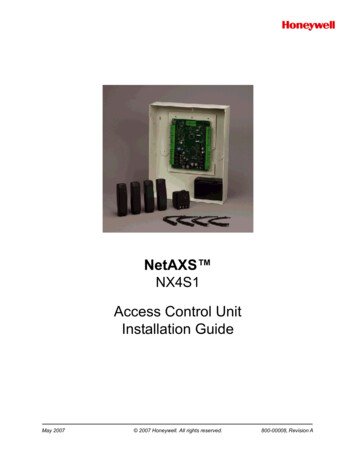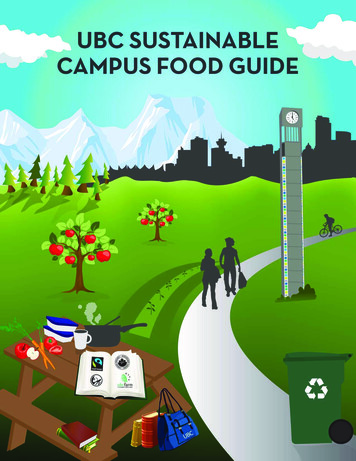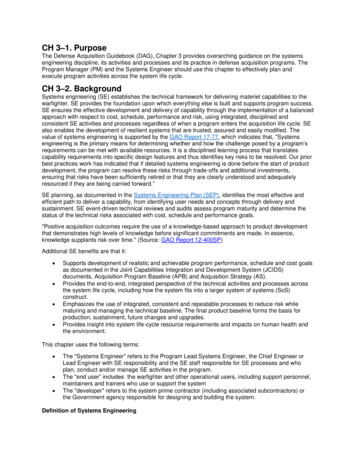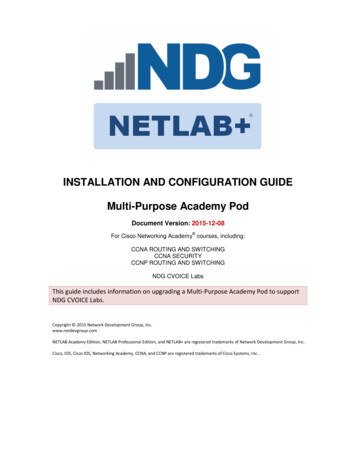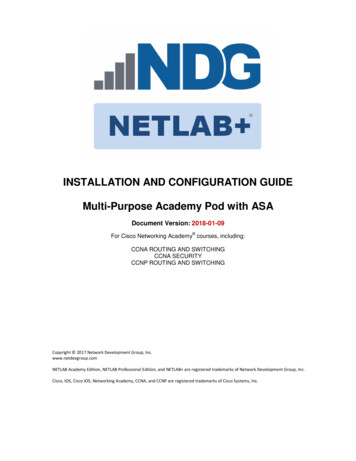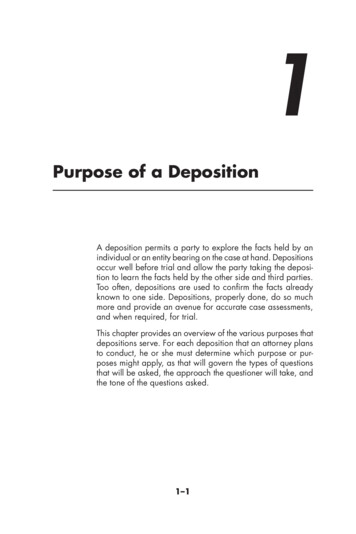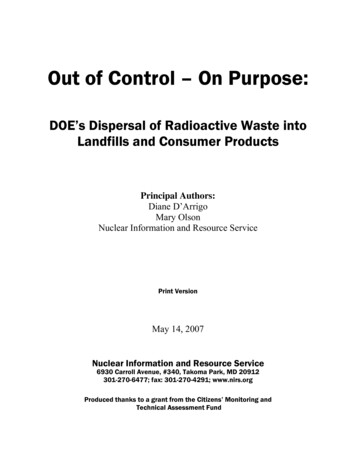
Transcription
Out of Control – On Purpose:DOE’s Dispersal of Radioactive Waste intoLandfills and Consumer ProductsPrincipal Authors:Diane D’ArrigoMary OlsonNuclear Information and Resource ServicePrint VersionMay 14, 2007Nuclear Information and Resource Service6930 Carroll Avenue, #340, Takoma Park, MD 20912301-270-6477; fax: 301-270-4291; www.nirs.orgProduced thanks to a grant from the Citizens’ Monitoring andTechnical Assessment Fund
Out of Control – On Purpose:DOE’s Dispersal of Radioactive Waste intoLandfills and Consumer ProductsPrincipal Authors:Diane D’ArrigoMary OlsonNuclear Information and Resource ServiceContributorsDr. Marvin ResnikoffDan GuttmanCynthia FolkersMichael H. GibsonPrint VersionMay 14, 2007Nuclear Information and Resource Service6930 Carroll Avenue, #340, Takoma Park, MD 20912301-270-6477; fax: 301-270-4291; www.nirs.org2
Table of ContentsExecutive Summary . .Chapter 1: Introduction and Overview Chapter 2: Ionizing Radiation .Radiation Units . . . .Radioactive Emissions . . . Radiation Risk . . .page571010 -111213Chapter 3: Radiation Detection and Release 15Chapter 4: Preventing vs. Justifying Radioactive Releases:Reframing DOE’s Questions and Claims . 20Chapter 5: Timeline: Efforts to Remove Control Over Radioactive Waste .Terms for Used to Remove Control Over Radioactive Waste .2327Chapter 6: DOE’s Orders, Guidance and Support Documents . 28Chapter 7: How it Gets Out and Where it Goes Radiation Areas . Chapter 8: Where It Got Out in the Past and Is Causing Trouble Today:3 Case Histories Lowry Landfill, CO . . .Industrial Excess Landfill, Uniontown, OH . Witherspoon Radioactive Recycler, Knoxville, TN . .354247Chapter 9: Processors of Radioactive Waste and Materials . .52Chapter 10: What We Did, What We Learned, What to Do Next . Questions posed at Site Visits .6267 - 684748493
AppendicesABCDEFGHIJKLMNOPQ1999 Tennessee Radioactive Materials/Waste Processors Licenses and Licensees2006 Tennessee Radioactive Materials/Waste Processors Licenses and LicenseesDepartment of Energy press release: Secretarial Announcement Blocking Nickel Recycling at Oak Ridge and “prohibiting the release of all volumetrically contaminated metals”January 12, 2000Department of Energy press release: Secretarial Announcement of Suspension of Release of Materials (Recycling of Metals) from DOE Facilities July 13, 2000DOE Secretarial Memo on Release of Surplus and Scrap Materials July 13, 2000DOE Radiological Release of Property: Procedural Flow Chart2001 Tennessee Department of Environment and Conservation (TDEC) Division of Radiological Health White Paper streamlining accepting nuclear waste at landfills2006 TDEC Memo of Agreement between Divisions of Solid Waste and RadiologicalHealth allowing landfill disposal of radioactive waste as “special” without “permit-by-rule”DOE Internal Order 5400.5 Surface Contamination Release LevelsTable of Fatal Cancer Risk from Ionizing Radiation from Nuclear Regulatory Commission’s 1990 expanded ‘Below Regulatory Concern’ policyPublic Concerns Presented to Department of Energy re: 2001 Notice of Intent to Preparea Programmatic Environmental Impact Statement on the Disposition of Radioactive Materials/ Scrap Metals2007 Freedom of Information Act (FOIA) Request to DOE/NNSA re: All Authorized andSupplemental Radioactive Release Limits, submitted from NIRS“Concentrated Benefit over Diffuse Injury,” by John W. Gofman, M.D., Ph.D., and EganO'Connor, 1993Why Radioactive Wastes Should be Sequestered for the Full Duration of their Hazard:Considering the “MACS Effect,” by Judith Johnsrud, Ph.D.Reg. Guide 1.86, Atomic Energy Commission, June 1974References3/10/1981 Wall Street Journal article, pg. 1, “Want Skillets That Contain Atomic Waste?”4
EXECUTIVE SUMMARYBackgroundAre the byproducts of building nuclear weapons–andgenerating atomic electric power–getting out-ofcontrol—on purpose? Are they winding up in unregulated landfills and unrestricted re-uses, including consumer products? These questions inspired this studyby Nuclear Information and Resource Service on thepolicies and practices for releasing radioactively contaminated wastes, properties and materials belongingto the U.S. Department of Energy in its vast nuclearweapons production complex.The purpose of this project was to understand howmuch nuclear weapons-generated radioactive waste,material and property the Department of Energy(DOE) releases into the marketplace. We sought toidentify how the radioactivity gets out, legally andpractically, and to the extent possible, where it goes.Since the production of atomic power and weaponsinvolves many of the same radioactive-waste generating facilities throughout the nuclear fuel chain, wealso sought to understand the larger context in whichthis man-made radioactivity is managed and releasedinto general commerce.We reviewed DOE’s national and site-specific policies, guidance, rules and procedures which allowsome radioactive contamination out of the weaponscomplex. This DOE-generated radioactivity can godirectly to hazardous and solid waste facilities, torecyclers of scrap, concrete, plastics, soil, asphalt,rubble, paper, equipment and other media--none ofwhich are intended to take Atomic Energy Act regulated radioactivity.Since much basic information about ionizing radiation is written by those who seek to minimize concern about its impact, NIRS offers extensive framingof these issues including the difficulties of detectingradioactivity and concerns about bias and inadequacyof even the fundamental units of radiation. NIRS ismandated to work in the public interest, not the nuclear waste generators’ interest. Therefore, we emphasize the effects of small doses on the public andpoint to inadequacies of the “updated” radiation “protection standards.” The standards do not protect allphases of human development and instead assumethat the recipient of radiation doses is an adult male,and do not consider all of the known, potential healtheffects from ionizing radiation.A timeline of several decades of efforts by U.S. andinternational government and nuclear advocacy organizations to release and “justify” release of radioactive materials from control, and the opposition, ispresented. The key governance on continued controlvs. release is reviewed. It is clear from this recordthat there is, and has been for some time, a concertedand deliberate effort on the part of the Department ofEnergy to reduce and relieve the burden of radioactive waste that must be under institutional control.The report has a special focus on Tennessee, whichleads the nation in nuclear waste processors, incinerators, radioactive “recycling” and release from control.It gives new meaning to the state’s chosen motto,“The Volunteer State,” since residents and downwinders are at elevated risk for undisclosed, unmonitored, ongoing radiation exposure.Key Findings and RecommendationsThe key findings and recommendations of this report:Out of Control – On Purpose: DOE’s Dispersal ofRadioactive Waste into Landfills and ConsumerProducts are:The US Department of Energy (DOE) on its own andin conjunction with other federal, state and international agencies is directly and indirectly releasingnuclear waste, materials and property from radioactive controls within the vast Department of Energyweapons complex, into the public realm.DOE is allowing some radioactivity generated by itsactivities to go to unregulated disposal, recycling andreuse using its internal orders and guidance. By permitting radioactivity to go directly to unregulateddestinations and to licensed processors who subsequently release it, DOE is enabling manmade radioactivity to get out into the open marketplace, landfills, commercial recycling and into everyday consumer products, construction supplies and equipment,roads, piping, buildings, vehicles, playgrounds,basements, furniture, toys, zippers, personal items,without warning, notification or consent.This dispersal of supposedly small amounts is beingdone without comprehensive complex-wide tracking,without routine public reporting of the releases fromeach site and processor and usually without independent verification that it is within the self-imposedlimits.5
The DOE has failed to “improve record keeping orreporting” as required in the Secretarial memo whichannounced the ban on recycling radioactive metal. Norecords were found “related to a Headquarters tracking system developed by the Office of Managementand Administration” as promised in the 2000 DOESecretarial Memo. Thus, the public’s main questionsabout where contamination is going remain largelyunanswered.DOE should immediately implement clear, understandable reporting of all radioactive releases including amounts and types of radioactivity and the destinations, including those since the 2000 memo committing to doing so.NIRS is submitting a new Freedom of InformationAct request to the Department of Energy and National Nuclear Security Administration to identifyand quantify how much nuclear weapons-generatedradioactivity has been released, is being released andmay be released and its destinations. Our previousefforts have only begun to answer these questions.We encourage the public to make efforts to trackDOE’s releases from sites near them. We encouragethe public to comment on the DOE’s current proposalfor “restricted” recycling of radioactive metal.Ideally, DOE should shift its policies to conform withthe precautionary principle and work to prevent deliberate radioactive releases to uncontrolled destinations.The federal policies that allow radioactive waste outof control, with the important exception of the ban onrecycling radioactive metal, are resulting in increasedpotential for proliferation of radioactive releases intogeneral commerce, unregulated disposal sites, reuseand recycle. The chapter, Timeline: Efforts to Remove Control Over Radioactive Waste, reports ondecades of the DOE and other nuclear establishmentattempts to legalize releasing and dispersing nuclearwaste into commerce and uncontrolled disposal. Italso includes the successful prevention of those efforts by the concerned public, workers, local and stategovernments and affected industries.Some state governments are not working to preventreleases however. The State of Tennessee is licensingprocessors that can make the determination to “freerelease” radioactive materials and wastes for reuse,recycling or regular landfills. The report reviews thisand identifies some of the landfills that are receivingthis waste. The report points out the need for resi-dents of Tennessee and other states to investigatethese practices. Other states could be doing the same.The Department of Energy ban on radioactive metalrecycling, in conjunction with active monitoring bythe metal industries, appears to be successful in preventing radioactive metal from the weapons complexfrom getting into commerce in the United States.Most DOE sites we interviewed reported respectingthe ban even if the requirements were not incorporated into the written procedural manuals, which is ofconcern. There are pathways that the commercialnuclear industry could be taking to release radioactive metal since it is not bound by the DOE ban.There are releases of radioactive metal from international sources that must be confronted. There are alsoloopholes and efforts to bypass the ban that requirepublic vigilance and assertiveness to stop.The public call has been for the radioactive metalrecycling ban to be expanded to cover all nuclearwastes and contaminated materials, not only metals,and the loopholes plugged.DOE has internal orders and guidance that provide acomplicated roadmap to justify releasing radioactively contaminated waste, materials and property inviolation of Congressional intent, public will andDOE Secretarial statements made to the public in2000. The processes used to release radioactivelycontaminated materials from regulatory control arefar from comprehensive, consistent, or protective.DOE provides itself varying release levels and methods of compliance including reliance on institutionalmemory about whether an object might have beenexposed to radiation. The responsible action for DOEhere is to use precaution and halt release of any potentially contaminated materials and wastes.From the public perspective, more work needs to bedone to track, identify, demand accountability andstop DOE’s radioactive releases. Public interest andenvironmental organizations along with affected industries especially recyclers and landfill associations,unions and local governments must also continue totrack the Nuclear Regulatory Commission and theEnvironmental Protection Agency pathways for letting DOE and commercial nuclear waste out of control—on purpose. Public health, public interest, environmental organizations and the general publicshould join international allies in rejecting international recommendations that could lead to increasedrelease of radioactive materials in the U.S. andaround the world.6
CHAPTER 1: INTRODUCTION AND OVERVIEWThe objective of this study was to identify the nationaland site-specific policies, laws, regulations and procedures regarding the management and release (or clearance) of radioactive wastes, materials and propertyfrom the Department of Energy (DOE) nuclear weapons sites. The goal was to compare the national policiesto the actual practices being carried out at several sites:some closing and some continuing operation, somewith on-site or easy access to disposal capacity andsome with more limited access.and into everyday consumer products, constructionsupplies and equipment, roads, piping, buildings, vehicles, playground
14.05.2007 · The purpose of this project was to understand how much nuclear weapons-generated radioactive waste, material and property the Department of Energy (DOE) releases into the marketplace. We sought to identify how the radioactivity gets out, legally

